Global Health: Disease, Illness, DALYs and Biopower
VerifiedAdded on 2020/04/07
|10
|2878
|82
Essay
AI Summary
This assignment delves into critical aspects of global health, beginning with a distinction between disease and illness, and a critique of Disability-Adjusted Life Years (DALYs) as a measure of disease burden. It then explores Louis Pasteur's famous statement on the importance of the 'terrain' in infectious diseases, highlighting the significance of individual health and environment over pathogens. The essay further examines biopower within epidemiological establishments, particularly how risk groups are defined and how this relates to moral distinctions and inequalities. Finally, it discusses structural violence, emphasizing how economic and social inequalities manifest as vulnerability to disease and illness, using examples of health disparities and the impact of social factors on health outcomes. The assignment concludes by emphasizing the need for a holistic approach to global health that addresses both individual and systemic factors.
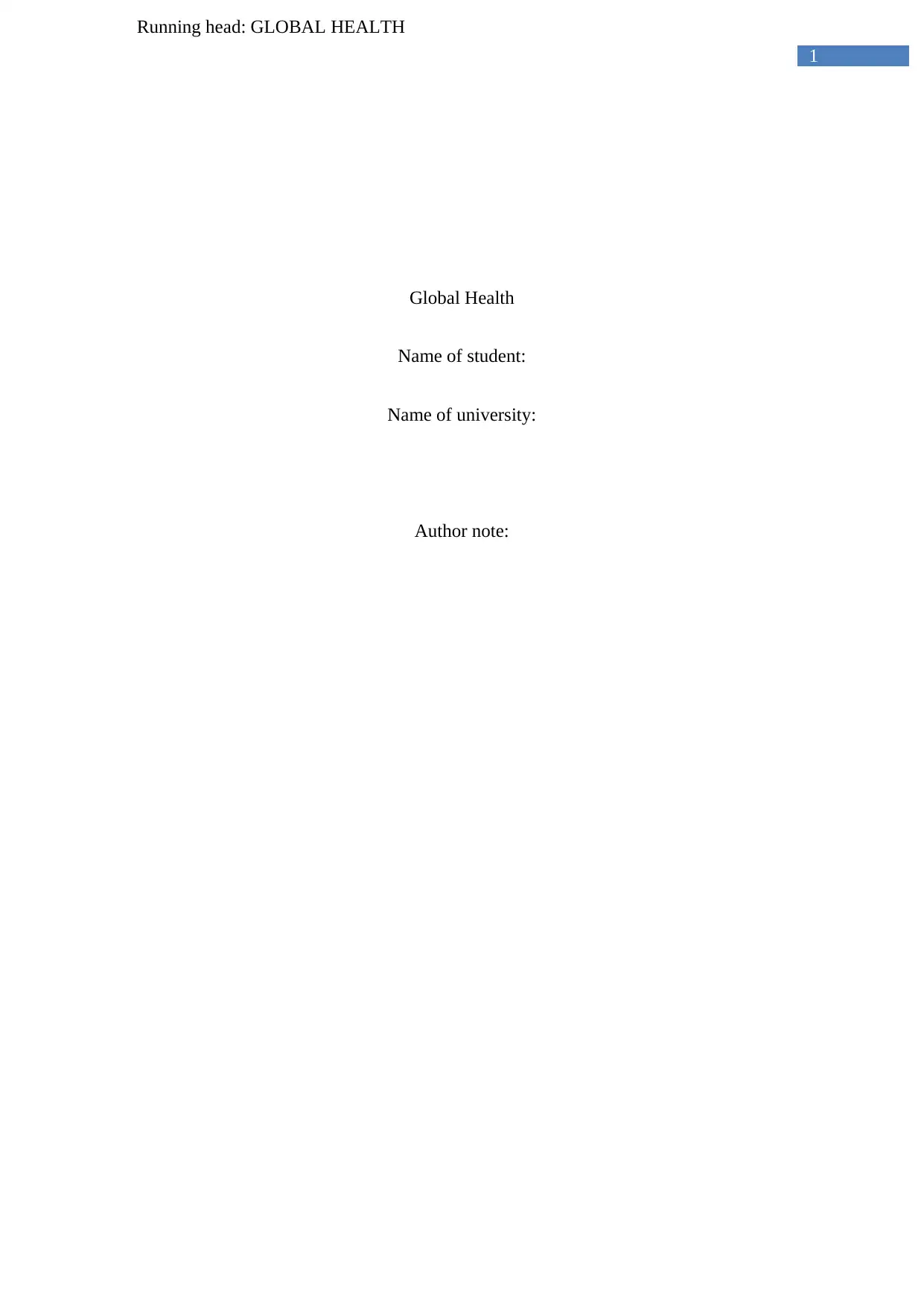
1
Running head: GLOBAL HEALTH
Global Health
Name of student:
Name of university:
Author note:
Running head: GLOBAL HEALTH
Global Health
Name of student:
Name of university:
Author note:
Paraphrase This Document
Need a fresh take? Get an instant paraphrase of this document with our AI Paraphraser
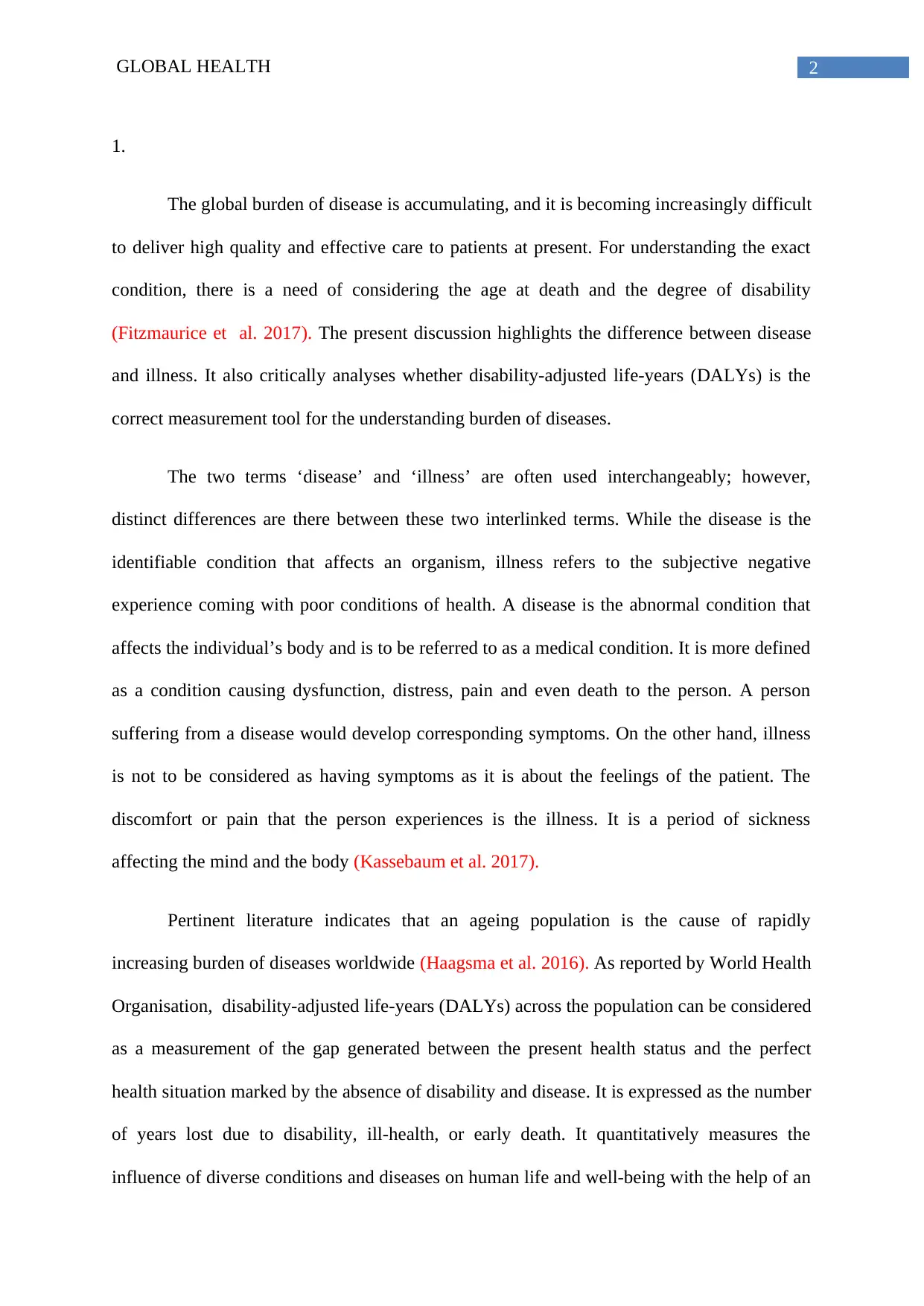
2GLOBAL HEALTH
1.
The global burden of disease is accumulating, and it is becoming increasingly difficult
to deliver high quality and effective care to patients at present. For understanding the exact
condition, there is a need of considering the age at death and the degree of disability
(Fitzmaurice et al. 2017). The present discussion highlights the difference between disease
and illness. It also critically analyses whether disability-adjusted life-years (DALYs) is the
correct measurement tool for the understanding burden of diseases.
The two terms ‘disease’ and ‘illness’ are often used interchangeably; however,
distinct differences are there between these two interlinked terms. While the disease is the
identifiable condition that affects an organism, illness refers to the subjective negative
experience coming with poor conditions of health. A disease is the abnormal condition that
affects the individual’s body and is to be referred to as a medical condition. It is more defined
as a condition causing dysfunction, distress, pain and even death to the person. A person
suffering from a disease would develop corresponding symptoms. On the other hand, illness
is not to be considered as having symptoms as it is about the feelings of the patient. The
discomfort or pain that the person experiences is the illness. It is a period of sickness
affecting the mind and the body (Kassebaum et al. 2017).
Pertinent literature indicates that an ageing population is the cause of rapidly
increasing burden of diseases worldwide (Haagsma et al. 2016). As reported by World Health
Organisation, disability-adjusted life-years (DALYs) across the population can be considered
as a measurement of the gap generated between the present health status and the perfect
health situation marked by the absence of disability and disease. It is expressed as the number
of years lost due to disability, ill-health, or early death. It quantitatively measures the
influence of diverse conditions and diseases on human life and well-being with the help of an
1.
The global burden of disease is accumulating, and it is becoming increasingly difficult
to deliver high quality and effective care to patients at present. For understanding the exact
condition, there is a need of considering the age at death and the degree of disability
(Fitzmaurice et al. 2017). The present discussion highlights the difference between disease
and illness. It also critically analyses whether disability-adjusted life-years (DALYs) is the
correct measurement tool for the understanding burden of diseases.
The two terms ‘disease’ and ‘illness’ are often used interchangeably; however,
distinct differences are there between these two interlinked terms. While the disease is the
identifiable condition that affects an organism, illness refers to the subjective negative
experience coming with poor conditions of health. A disease is the abnormal condition that
affects the individual’s body and is to be referred to as a medical condition. It is more defined
as a condition causing dysfunction, distress, pain and even death to the person. A person
suffering from a disease would develop corresponding symptoms. On the other hand, illness
is not to be considered as having symptoms as it is about the feelings of the patient. The
discomfort or pain that the person experiences is the illness. It is a period of sickness
affecting the mind and the body (Kassebaum et al. 2017).
Pertinent literature indicates that an ageing population is the cause of rapidly
increasing burden of diseases worldwide (Haagsma et al. 2016). As reported by World Health
Organisation, disability-adjusted life-years (DALYs) across the population can be considered
as a measurement of the gap generated between the present health status and the perfect
health situation marked by the absence of disability and disease. It is expressed as the number
of years lost due to disability, ill-health, or early death. It quantitatively measures the
influence of diverse conditions and diseases on human life and well-being with the help of an
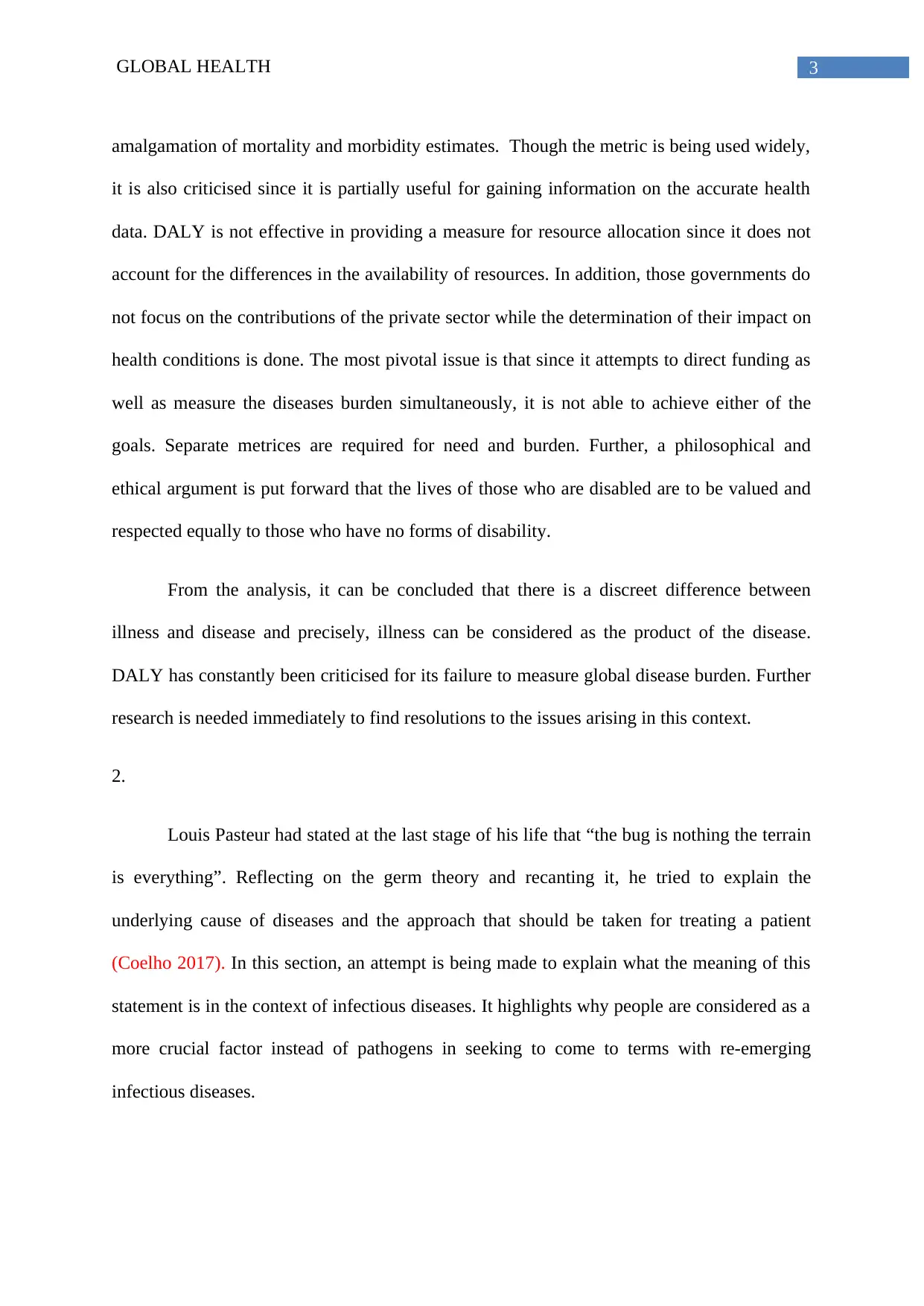
3GLOBAL HEALTH
amalgamation of mortality and morbidity estimates. Though the metric is being used widely,
it is also criticised since it is partially useful for gaining information on the accurate health
data. DALY is not effective in providing a measure for resource allocation since it does not
account for the differences in the availability of resources. In addition, those governments do
not focus on the contributions of the private sector while the determination of their impact on
health conditions is done. The most pivotal issue is that since it attempts to direct funding as
well as measure the diseases burden simultaneously, it is not able to achieve either of the
goals. Separate metrices are required for need and burden. Further, a philosophical and
ethical argument is put forward that the lives of those who are disabled are to be valued and
respected equally to those who have no forms of disability.
From the analysis, it can be concluded that there is a discreet difference between
illness and disease and precisely, illness can be considered as the product of the disease.
DALY has constantly been criticised for its failure to measure global disease burden. Further
research is needed immediately to find resolutions to the issues arising in this context.
2.
Louis Pasteur had stated at the last stage of his life that “the bug is nothing the terrain
is everything”. Reflecting on the germ theory and recanting it, he tried to explain the
underlying cause of diseases and the approach that should be taken for treating a patient
(Coelho 2017). In this section, an attempt is being made to explain what the meaning of this
statement is in the context of infectious diseases. It highlights why people are considered as a
more crucial factor instead of pathogens in seeking to come to terms with re-emerging
infectious diseases.
amalgamation of mortality and morbidity estimates. Though the metric is being used widely,
it is also criticised since it is partially useful for gaining information on the accurate health
data. DALY is not effective in providing a measure for resource allocation since it does not
account for the differences in the availability of resources. In addition, those governments do
not focus on the contributions of the private sector while the determination of their impact on
health conditions is done. The most pivotal issue is that since it attempts to direct funding as
well as measure the diseases burden simultaneously, it is not able to achieve either of the
goals. Separate metrices are required for need and burden. Further, a philosophical and
ethical argument is put forward that the lives of those who are disabled are to be valued and
respected equally to those who have no forms of disability.
From the analysis, it can be concluded that there is a discreet difference between
illness and disease and precisely, illness can be considered as the product of the disease.
DALY has constantly been criticised for its failure to measure global disease burden. Further
research is needed immediately to find resolutions to the issues arising in this context.
2.
Louis Pasteur had stated at the last stage of his life that “the bug is nothing the terrain
is everything”. Reflecting on the germ theory and recanting it, he tried to explain the
underlying cause of diseases and the approach that should be taken for treating a patient
(Coelho 2017). In this section, an attempt is being made to explain what the meaning of this
statement is in the context of infectious diseases. It highlights why people are considered as a
more crucial factor instead of pathogens in seeking to come to terms with re-emerging
infectious diseases.
⊘ This is a preview!⊘
Do you want full access?
Subscribe today to unlock all pages.

Trusted by 1+ million students worldwide
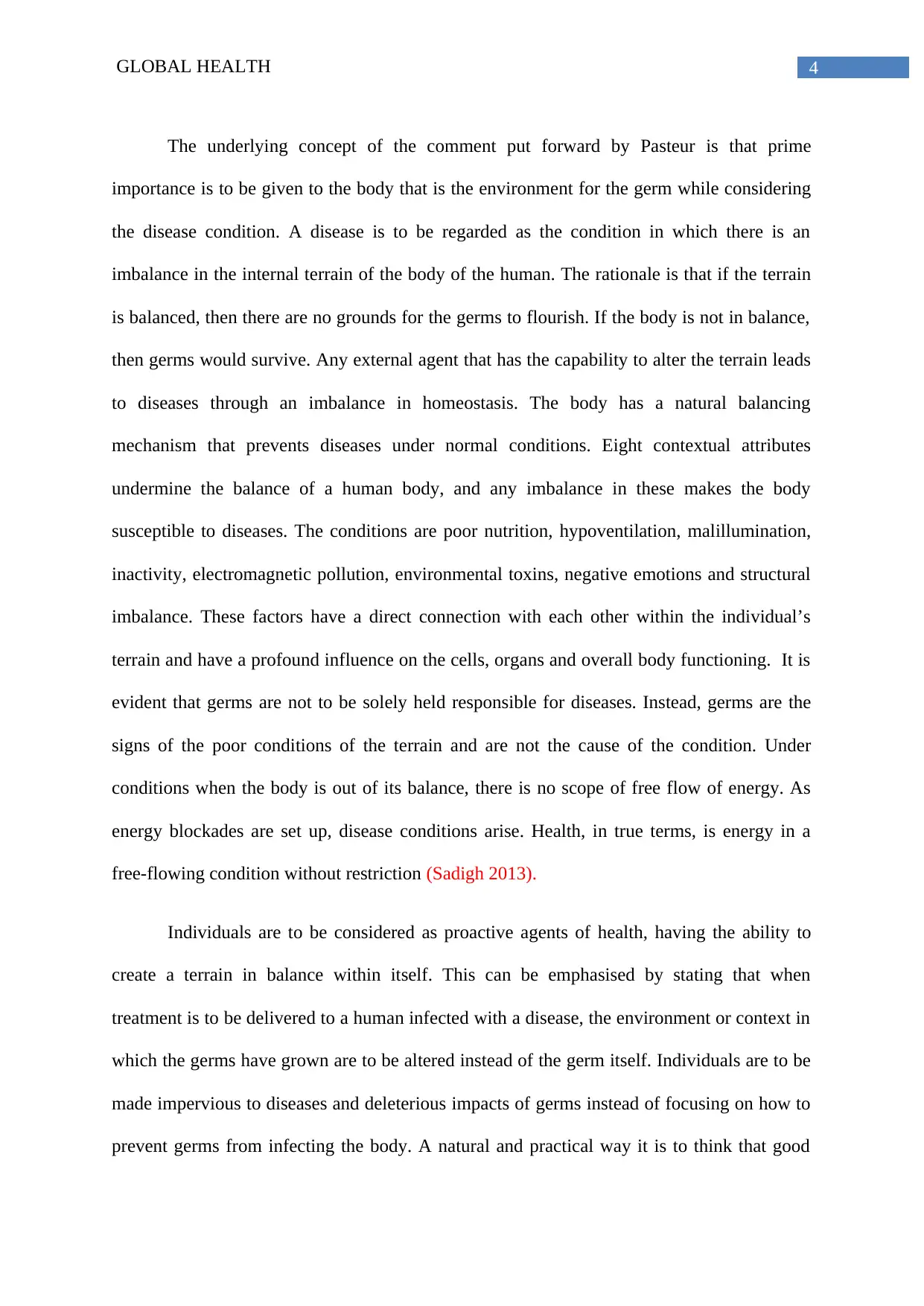
4GLOBAL HEALTH
The underlying concept of the comment put forward by Pasteur is that prime
importance is to be given to the body that is the environment for the germ while considering
the disease condition. A disease is to be regarded as the condition in which there is an
imbalance in the internal terrain of the body of the human. The rationale is that if the terrain
is balanced, then there are no grounds for the germs to flourish. If the body is not in balance,
then germs would survive. Any external agent that has the capability to alter the terrain leads
to diseases through an imbalance in homeostasis. The body has a natural balancing
mechanism that prevents diseases under normal conditions. Eight contextual attributes
undermine the balance of a human body, and any imbalance in these makes the body
susceptible to diseases. The conditions are poor nutrition, hypoventilation, malillumination,
inactivity, electromagnetic pollution, environmental toxins, negative emotions and structural
imbalance. These factors have a direct connection with each other within the individual’s
terrain and have a profound influence on the cells, organs and overall body functioning. It is
evident that germs are not to be solely held responsible for diseases. Instead, germs are the
signs of the poor conditions of the terrain and are not the cause of the condition. Under
conditions when the body is out of its balance, there is no scope of free flow of energy. As
energy blockades are set up, disease conditions arise. Health, in true terms, is energy in a
free-flowing condition without restriction (Sadigh 2013).
Individuals are to be considered as proactive agents of health, having the ability to
create a terrain in balance within itself. This can be emphasised by stating that when
treatment is to be delivered to a human infected with a disease, the environment or context in
which the germs have grown are to be altered instead of the germ itself. Individuals are to be
made impervious to diseases and deleterious impacts of germs instead of focusing on how to
prevent germs from infecting the body. A natural and practical way it is to think that good
The underlying concept of the comment put forward by Pasteur is that prime
importance is to be given to the body that is the environment for the germ while considering
the disease condition. A disease is to be regarded as the condition in which there is an
imbalance in the internal terrain of the body of the human. The rationale is that if the terrain
is balanced, then there are no grounds for the germs to flourish. If the body is not in balance,
then germs would survive. Any external agent that has the capability to alter the terrain leads
to diseases through an imbalance in homeostasis. The body has a natural balancing
mechanism that prevents diseases under normal conditions. Eight contextual attributes
undermine the balance of a human body, and any imbalance in these makes the body
susceptible to diseases. The conditions are poor nutrition, hypoventilation, malillumination,
inactivity, electromagnetic pollution, environmental toxins, negative emotions and structural
imbalance. These factors have a direct connection with each other within the individual’s
terrain and have a profound influence on the cells, organs and overall body functioning. It is
evident that germs are not to be solely held responsible for diseases. Instead, germs are the
signs of the poor conditions of the terrain and are not the cause of the condition. Under
conditions when the body is out of its balance, there is no scope of free flow of energy. As
energy blockades are set up, disease conditions arise. Health, in true terms, is energy in a
free-flowing condition without restriction (Sadigh 2013).
Individuals are to be considered as proactive agents of health, having the ability to
create a terrain in balance within itself. This can be emphasised by stating that when
treatment is to be delivered to a human infected with a disease, the environment or context in
which the germs have grown are to be altered instead of the germ itself. Individuals are to be
made impervious to diseases and deleterious impacts of germs instead of focusing on how to
prevent germs from infecting the body. A natural and practical way it is to think that good
Paraphrase This Document
Need a fresh take? Get an instant paraphrase of this document with our AI Paraphraser
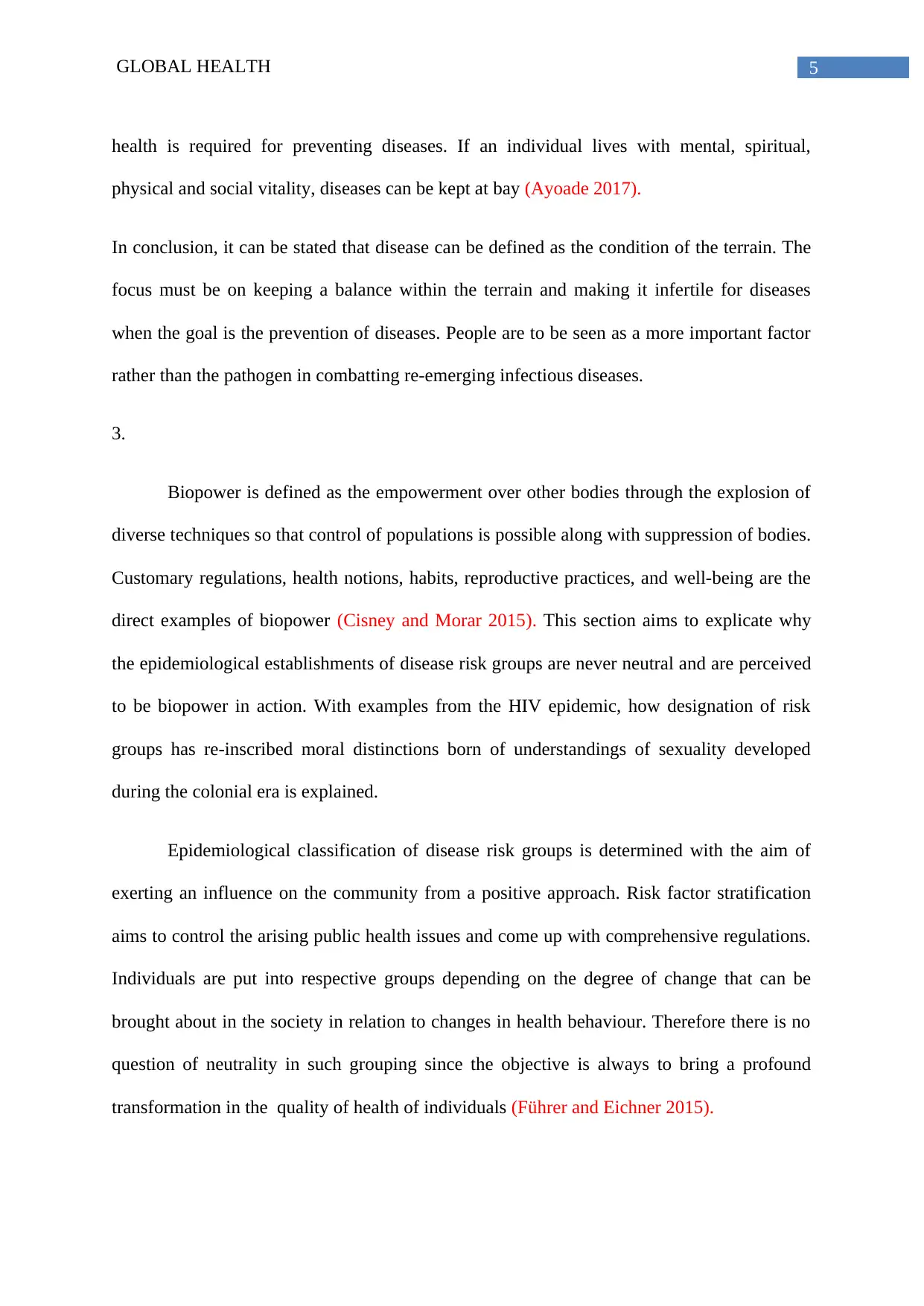
5GLOBAL HEALTH
health is required for preventing diseases. If an individual lives with mental, spiritual,
physical and social vitality, diseases can be kept at bay (Ayoade 2017).
In conclusion, it can be stated that disease can be defined as the condition of the terrain. The
focus must be on keeping a balance within the terrain and making it infertile for diseases
when the goal is the prevention of diseases. People are to be seen as a more important factor
rather than the pathogen in combatting re-emerging infectious diseases.
3.
Biopower is defined as the empowerment over other bodies through the explosion of
diverse techniques so that control of populations is possible along with suppression of bodies.
Customary regulations, health notions, habits, reproductive practices, and well-being are the
direct examples of biopower (Cisney and Morar 2015). This section aims to explicate why
the epidemiological establishments of disease risk groups are never neutral and are perceived
to be biopower in action. With examples from the HIV epidemic, how designation of risk
groups has re-inscribed moral distinctions born of understandings of sexuality developed
during the colonial era is explained.
Epidemiological classification of disease risk groups is determined with the aim of
exerting an influence on the community from a positive approach. Risk factor stratification
aims to control the arising public health issues and come up with comprehensive regulations.
Individuals are put into respective groups depending on the degree of change that can be
brought about in the society in relation to changes in health behaviour. Therefore there is no
question of neutrality in such grouping since the objective is always to bring a profound
transformation in the quality of health of individuals (Führer and Eichner 2015).
health is required for preventing diseases. If an individual lives with mental, spiritual,
physical and social vitality, diseases can be kept at bay (Ayoade 2017).
In conclusion, it can be stated that disease can be defined as the condition of the terrain. The
focus must be on keeping a balance within the terrain and making it infertile for diseases
when the goal is the prevention of diseases. People are to be seen as a more important factor
rather than the pathogen in combatting re-emerging infectious diseases.
3.
Biopower is defined as the empowerment over other bodies through the explosion of
diverse techniques so that control of populations is possible along with suppression of bodies.
Customary regulations, health notions, habits, reproductive practices, and well-being are the
direct examples of biopower (Cisney and Morar 2015). This section aims to explicate why
the epidemiological establishments of disease risk groups are never neutral and are perceived
to be biopower in action. With examples from the HIV epidemic, how designation of risk
groups has re-inscribed moral distinctions born of understandings of sexuality developed
during the colonial era is explained.
Epidemiological classification of disease risk groups is determined with the aim of
exerting an influence on the community from a positive approach. Risk factor stratification
aims to control the arising public health issues and come up with comprehensive regulations.
Individuals are put into respective groups depending on the degree of change that can be
brought about in the society in relation to changes in health behaviour. Therefore there is no
question of neutrality in such grouping since the objective is always to bring a profound
transformation in the quality of health of individuals (Führer and Eichner 2015).
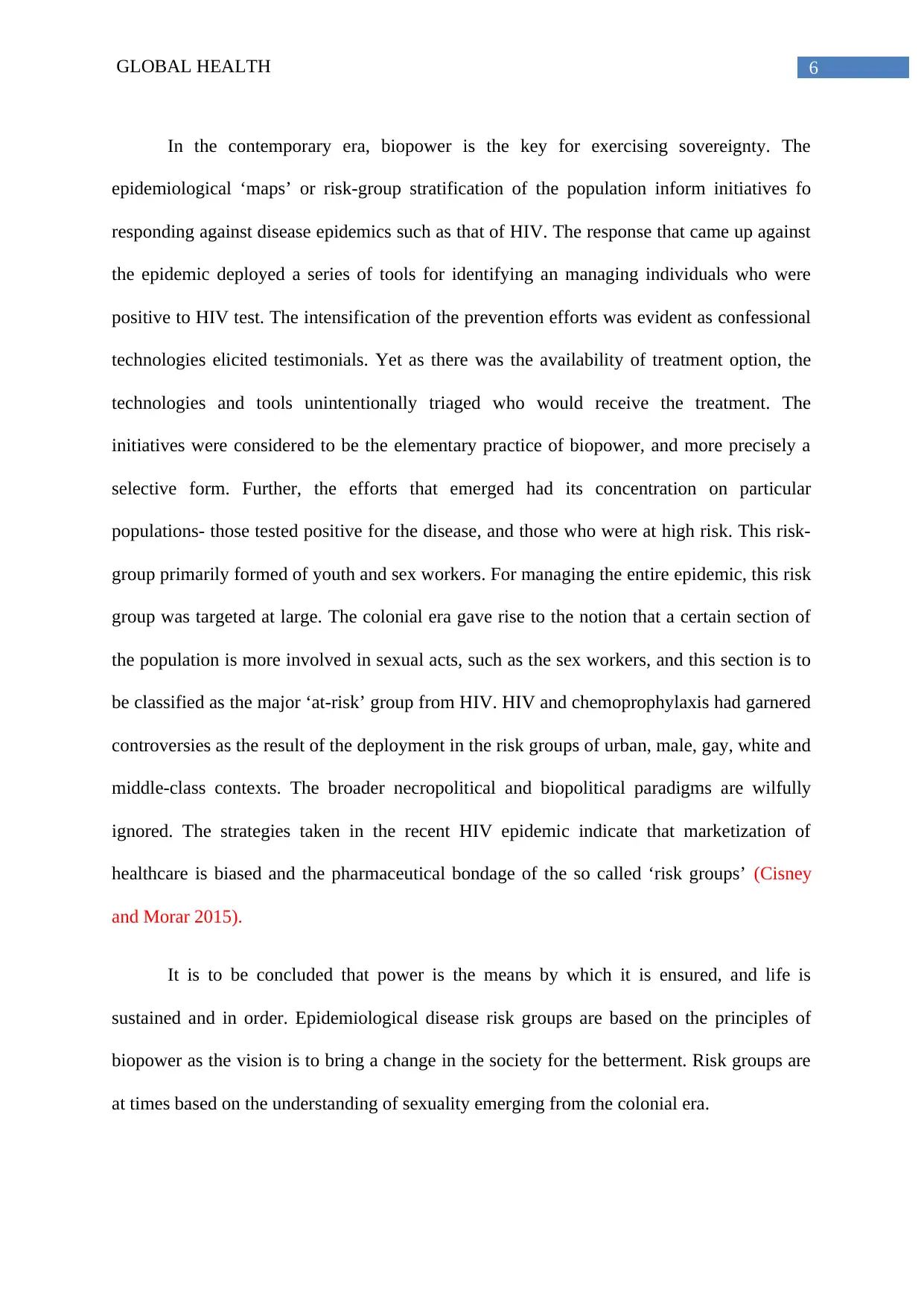
6GLOBAL HEALTH
In the contemporary era, biopower is the key for exercising sovereignty. The
epidemiological ‘maps’ or risk-group stratification of the population inform initiatives fo
responding against disease epidemics such as that of HIV. The response that came up against
the epidemic deployed a series of tools for identifying an managing individuals who were
positive to HIV test. The intensification of the prevention efforts was evident as confessional
technologies elicited testimonials. Yet as there was the availability of treatment option, the
technologies and tools unintentionally triaged who would receive the treatment. The
initiatives were considered to be the elementary practice of biopower, and more precisely a
selective form. Further, the efforts that emerged had its concentration on particular
populations- those tested positive for the disease, and those who were at high risk. This risk-
group primarily formed of youth and sex workers. For managing the entire epidemic, this risk
group was targeted at large. The colonial era gave rise to the notion that a certain section of
the population is more involved in sexual acts, such as the sex workers, and this section is to
be classified as the major ‘at-risk’ group from HIV. HIV and chemoprophylaxis had garnered
controversies as the result of the deployment in the risk groups of urban, male, gay, white and
middle-class contexts. The broader necropolitical and biopolitical paradigms are wilfully
ignored. The strategies taken in the recent HIV epidemic indicate that marketization of
healthcare is biased and the pharmaceutical bondage of the so called ‘risk groups’ (Cisney
and Morar 2015).
It is to be concluded that power is the means by which it is ensured, and life is
sustained and in order. Epidemiological disease risk groups are based on the principles of
biopower as the vision is to bring a change in the society for the betterment. Risk groups are
at times based on the understanding of sexuality emerging from the colonial era.
In the contemporary era, biopower is the key for exercising sovereignty. The
epidemiological ‘maps’ or risk-group stratification of the population inform initiatives fo
responding against disease epidemics such as that of HIV. The response that came up against
the epidemic deployed a series of tools for identifying an managing individuals who were
positive to HIV test. The intensification of the prevention efforts was evident as confessional
technologies elicited testimonials. Yet as there was the availability of treatment option, the
technologies and tools unintentionally triaged who would receive the treatment. The
initiatives were considered to be the elementary practice of biopower, and more precisely a
selective form. Further, the efforts that emerged had its concentration on particular
populations- those tested positive for the disease, and those who were at high risk. This risk-
group primarily formed of youth and sex workers. For managing the entire epidemic, this risk
group was targeted at large. The colonial era gave rise to the notion that a certain section of
the population is more involved in sexual acts, such as the sex workers, and this section is to
be classified as the major ‘at-risk’ group from HIV. HIV and chemoprophylaxis had garnered
controversies as the result of the deployment in the risk groups of urban, male, gay, white and
middle-class contexts. The broader necropolitical and biopolitical paradigms are wilfully
ignored. The strategies taken in the recent HIV epidemic indicate that marketization of
healthcare is biased and the pharmaceutical bondage of the so called ‘risk groups’ (Cisney
and Morar 2015).
It is to be concluded that power is the means by which it is ensured, and life is
sustained and in order. Epidemiological disease risk groups are based on the principles of
biopower as the vision is to bring a change in the society for the betterment. Risk groups are
at times based on the understanding of sexuality emerging from the colonial era.
⊘ This is a preview!⊘
Do you want full access?
Subscribe today to unlock all pages.

Trusted by 1+ million students worldwide
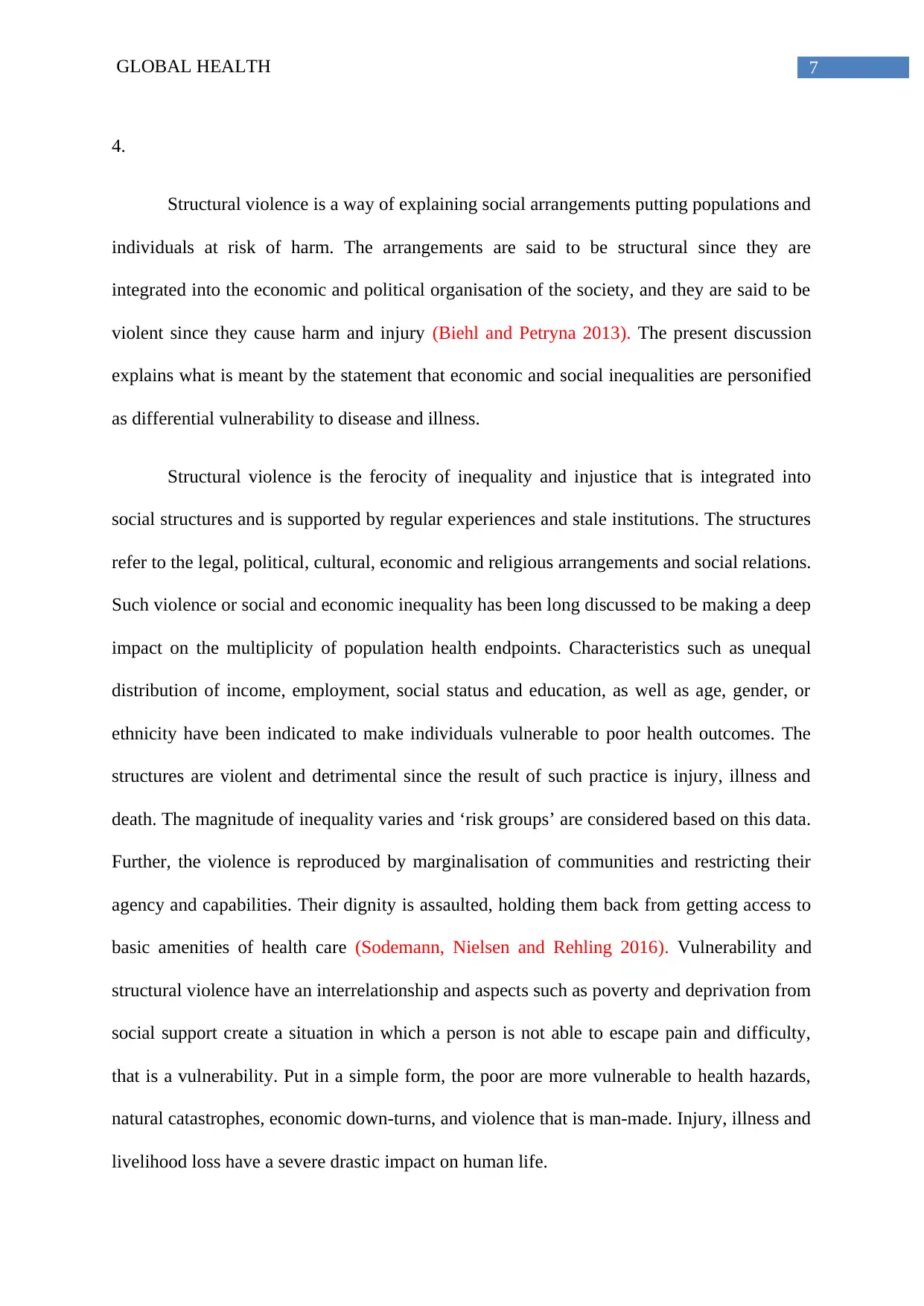
7GLOBAL HEALTH
4.
Structural violence is a way of explaining social arrangements putting populations and
individuals at risk of harm. The arrangements are said to be structural since they are
integrated into the economic and political organisation of the society, and they are said to be
violent since they cause harm and injury (Biehl and Petryna 2013). The present discussion
explains what is meant by the statement that economic and social inequalities are personified
as differential vulnerability to disease and illness.
Structural violence is the ferocity of inequality and injustice that is integrated into
social structures and is supported by regular experiences and stale institutions. The structures
refer to the legal, political, cultural, economic and religious arrangements and social relations.
Such violence or social and economic inequality has been long discussed to be making a deep
impact on the multiplicity of population health endpoints. Characteristics such as unequal
distribution of income, employment, social status and education, as well as age, gender, or
ethnicity have been indicated to make individuals vulnerable to poor health outcomes. The
structures are violent and detrimental since the result of such practice is injury, illness and
death. The magnitude of inequality varies and ‘risk groups’ are considered based on this data.
Further, the violence is reproduced by marginalisation of communities and restricting their
agency and capabilities. Their dignity is assaulted, holding them back from getting access to
basic amenities of health care (Sodemann, Nielsen and Rehling 2016). Vulnerability and
structural violence have an interrelationship and aspects such as poverty and deprivation from
social support create a situation in which a person is not able to escape pain and difficulty,
that is a vulnerability. Put in a simple form, the poor are more vulnerable to health hazards,
natural catastrophes, economic down-turns, and violence that is man-made. Injury, illness and
livelihood loss have a severe drastic impact on human life.
4.
Structural violence is a way of explaining social arrangements putting populations and
individuals at risk of harm. The arrangements are said to be structural since they are
integrated into the economic and political organisation of the society, and they are said to be
violent since they cause harm and injury (Biehl and Petryna 2013). The present discussion
explains what is meant by the statement that economic and social inequalities are personified
as differential vulnerability to disease and illness.
Structural violence is the ferocity of inequality and injustice that is integrated into
social structures and is supported by regular experiences and stale institutions. The structures
refer to the legal, political, cultural, economic and religious arrangements and social relations.
Such violence or social and economic inequality has been long discussed to be making a deep
impact on the multiplicity of population health endpoints. Characteristics such as unequal
distribution of income, employment, social status and education, as well as age, gender, or
ethnicity have been indicated to make individuals vulnerable to poor health outcomes. The
structures are violent and detrimental since the result of such practice is injury, illness and
death. The magnitude of inequality varies and ‘risk groups’ are considered based on this data.
Further, the violence is reproduced by marginalisation of communities and restricting their
agency and capabilities. Their dignity is assaulted, holding them back from getting access to
basic amenities of health care (Sodemann, Nielsen and Rehling 2016). Vulnerability and
structural violence have an interrelationship and aspects such as poverty and deprivation from
social support create a situation in which a person is not able to escape pain and difficulty,
that is a vulnerability. Put in a simple form, the poor are more vulnerable to health hazards,
natural catastrophes, economic down-turns, and violence that is man-made. Injury, illness and
livelihood loss have a severe drastic impact on human life.
Paraphrase This Document
Need a fresh take? Get an instant paraphrase of this document with our AI Paraphraser
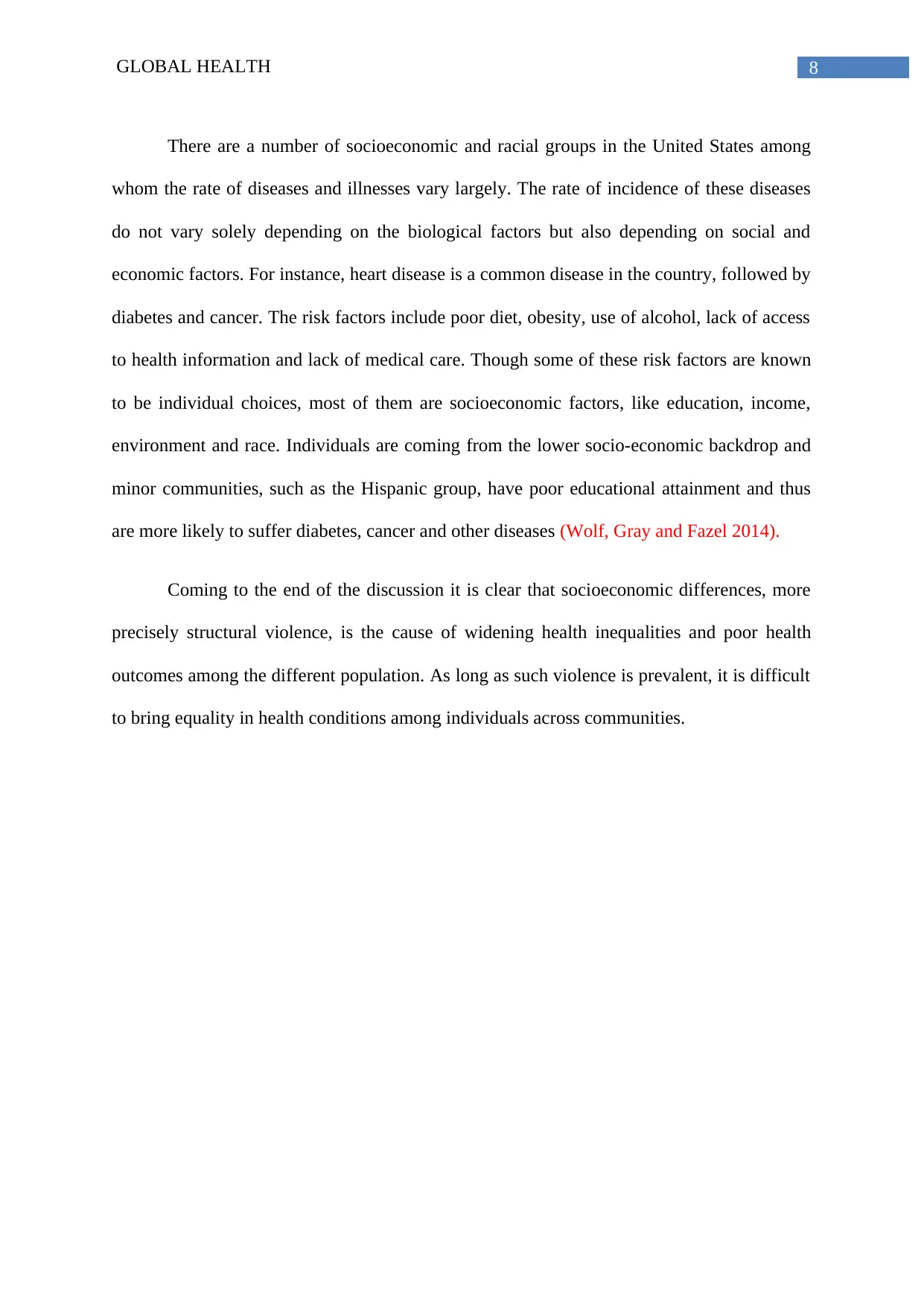
8GLOBAL HEALTH
There are a number of socioeconomic and racial groups in the United States among
whom the rate of diseases and illnesses vary largely. The rate of incidence of these diseases
do not vary solely depending on the biological factors but also depending on social and
economic factors. For instance, heart disease is a common disease in the country, followed by
diabetes and cancer. The risk factors include poor diet, obesity, use of alcohol, lack of access
to health information and lack of medical care. Though some of these risk factors are known
to be individual choices, most of them are socioeconomic factors, like education, income,
environment and race. Individuals are coming from the lower socio-economic backdrop and
minor communities, such as the Hispanic group, have poor educational attainment and thus
are more likely to suffer diabetes, cancer and other diseases (Wolf, Gray and Fazel 2014).
Coming to the end of the discussion it is clear that socioeconomic differences, more
precisely structural violence, is the cause of widening health inequalities and poor health
outcomes among the different population. As long as such violence is prevalent, it is difficult
to bring equality in health conditions among individuals across communities.
There are a number of socioeconomic and racial groups in the United States among
whom the rate of diseases and illnesses vary largely. The rate of incidence of these diseases
do not vary solely depending on the biological factors but also depending on social and
economic factors. For instance, heart disease is a common disease in the country, followed by
diabetes and cancer. The risk factors include poor diet, obesity, use of alcohol, lack of access
to health information and lack of medical care. Though some of these risk factors are known
to be individual choices, most of them are socioeconomic factors, like education, income,
environment and race. Individuals are coming from the lower socio-economic backdrop and
minor communities, such as the Hispanic group, have poor educational attainment and thus
are more likely to suffer diabetes, cancer and other diseases (Wolf, Gray and Fazel 2014).
Coming to the end of the discussion it is clear that socioeconomic differences, more
precisely structural violence, is the cause of widening health inequalities and poor health
outcomes among the different population. As long as such violence is prevalent, it is difficult
to bring equality in health conditions among individuals across communities.
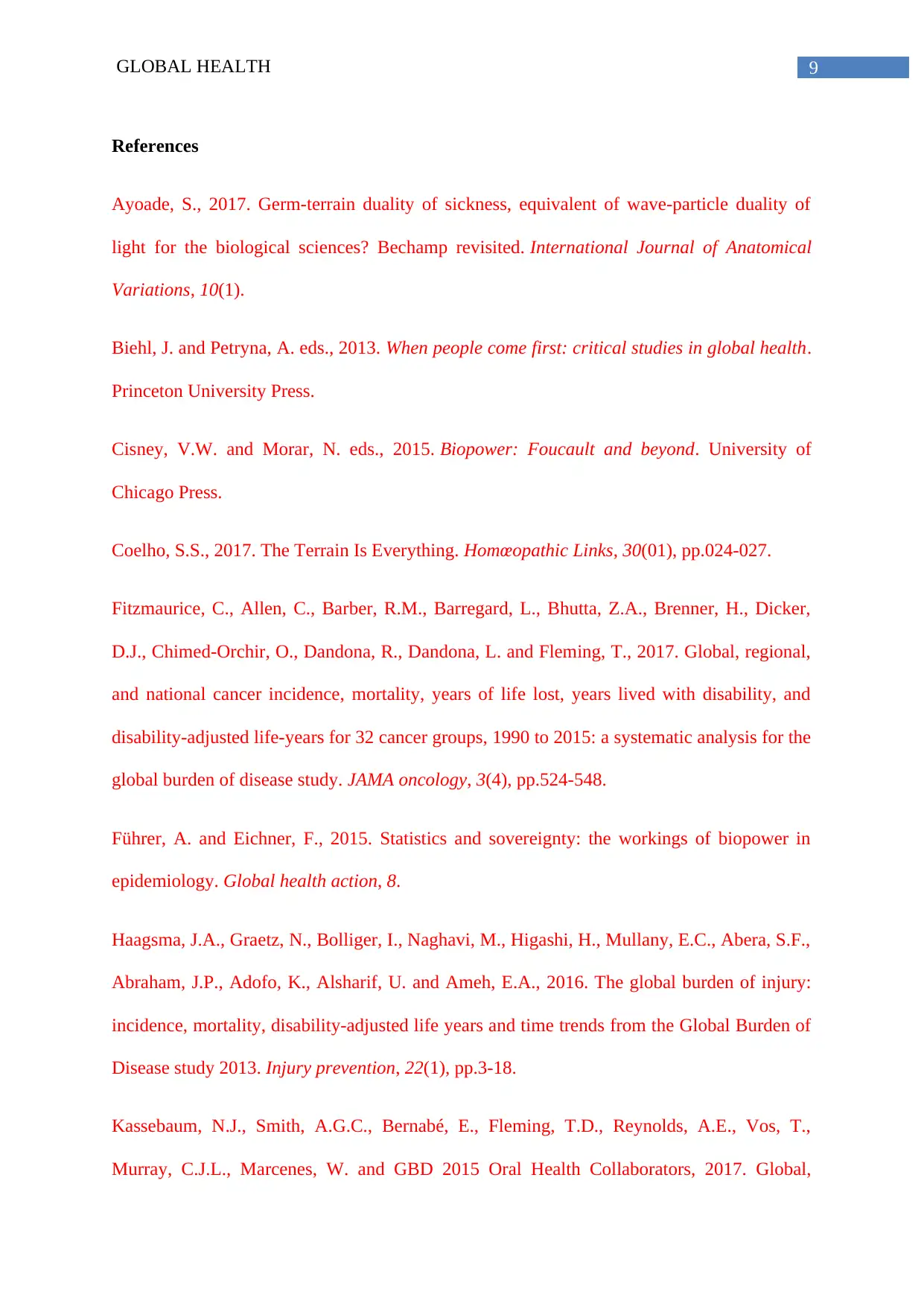
9GLOBAL HEALTH
References
Ayoade, S., 2017. Germ-terrain duality of sickness, equivalent of wave-particle duality of
light for the biological sciences? Bechamp revisited. International Journal of Anatomical
Variations, 10(1).
Biehl, J. and Petryna, A. eds., 2013. When people come first: critical studies in global health.
Princeton University Press.
Cisney, V.W. and Morar, N. eds., 2015. Biopower: Foucault and beyond. University of
Chicago Press.
Coelho, S.S., 2017. The Terrain Is Everything. Homœopathic Links, 30(01), pp.024-027.
Fitzmaurice, C., Allen, C., Barber, R.M., Barregard, L., Bhutta, Z.A., Brenner, H., Dicker,
D.J., Chimed-Orchir, O., Dandona, R., Dandona, L. and Fleming, T., 2017. Global, regional,
and national cancer incidence, mortality, years of life lost, years lived with disability, and
disability-adjusted life-years for 32 cancer groups, 1990 to 2015: a systematic analysis for the
global burden of disease study. JAMA oncology, 3(4), pp.524-548.
Führer, A. and Eichner, F., 2015. Statistics and sovereignty: the workings of biopower in
epidemiology. Global health action, 8.
Haagsma, J.A., Graetz, N., Bolliger, I., Naghavi, M., Higashi, H., Mullany, E.C., Abera, S.F.,
Abraham, J.P., Adofo, K., Alsharif, U. and Ameh, E.A., 2016. The global burden of injury:
incidence, mortality, disability-adjusted life years and time trends from the Global Burden of
Disease study 2013. Injury prevention, 22(1), pp.3-18.
Kassebaum, N.J., Smith, A.G.C., Bernabé, E., Fleming, T.D., Reynolds, A.E., Vos, T.,
Murray, C.J.L., Marcenes, W. and GBD 2015 Oral Health Collaborators, 2017. Global,
References
Ayoade, S., 2017. Germ-terrain duality of sickness, equivalent of wave-particle duality of
light for the biological sciences? Bechamp revisited. International Journal of Anatomical
Variations, 10(1).
Biehl, J. and Petryna, A. eds., 2013. When people come first: critical studies in global health.
Princeton University Press.
Cisney, V.W. and Morar, N. eds., 2015. Biopower: Foucault and beyond. University of
Chicago Press.
Coelho, S.S., 2017. The Terrain Is Everything. Homœopathic Links, 30(01), pp.024-027.
Fitzmaurice, C., Allen, C., Barber, R.M., Barregard, L., Bhutta, Z.A., Brenner, H., Dicker,
D.J., Chimed-Orchir, O., Dandona, R., Dandona, L. and Fleming, T., 2017. Global, regional,
and national cancer incidence, mortality, years of life lost, years lived with disability, and
disability-adjusted life-years for 32 cancer groups, 1990 to 2015: a systematic analysis for the
global burden of disease study. JAMA oncology, 3(4), pp.524-548.
Führer, A. and Eichner, F., 2015. Statistics and sovereignty: the workings of biopower in
epidemiology. Global health action, 8.
Haagsma, J.A., Graetz, N., Bolliger, I., Naghavi, M., Higashi, H., Mullany, E.C., Abera, S.F.,
Abraham, J.P., Adofo, K., Alsharif, U. and Ameh, E.A., 2016. The global burden of injury:
incidence, mortality, disability-adjusted life years and time trends from the Global Burden of
Disease study 2013. Injury prevention, 22(1), pp.3-18.
Kassebaum, N.J., Smith, A.G.C., Bernabé, E., Fleming, T.D., Reynolds, A.E., Vos, T.,
Murray, C.J.L., Marcenes, W. and GBD 2015 Oral Health Collaborators, 2017. Global,
⊘ This is a preview!⊘
Do you want full access?
Subscribe today to unlock all pages.

Trusted by 1+ million students worldwide
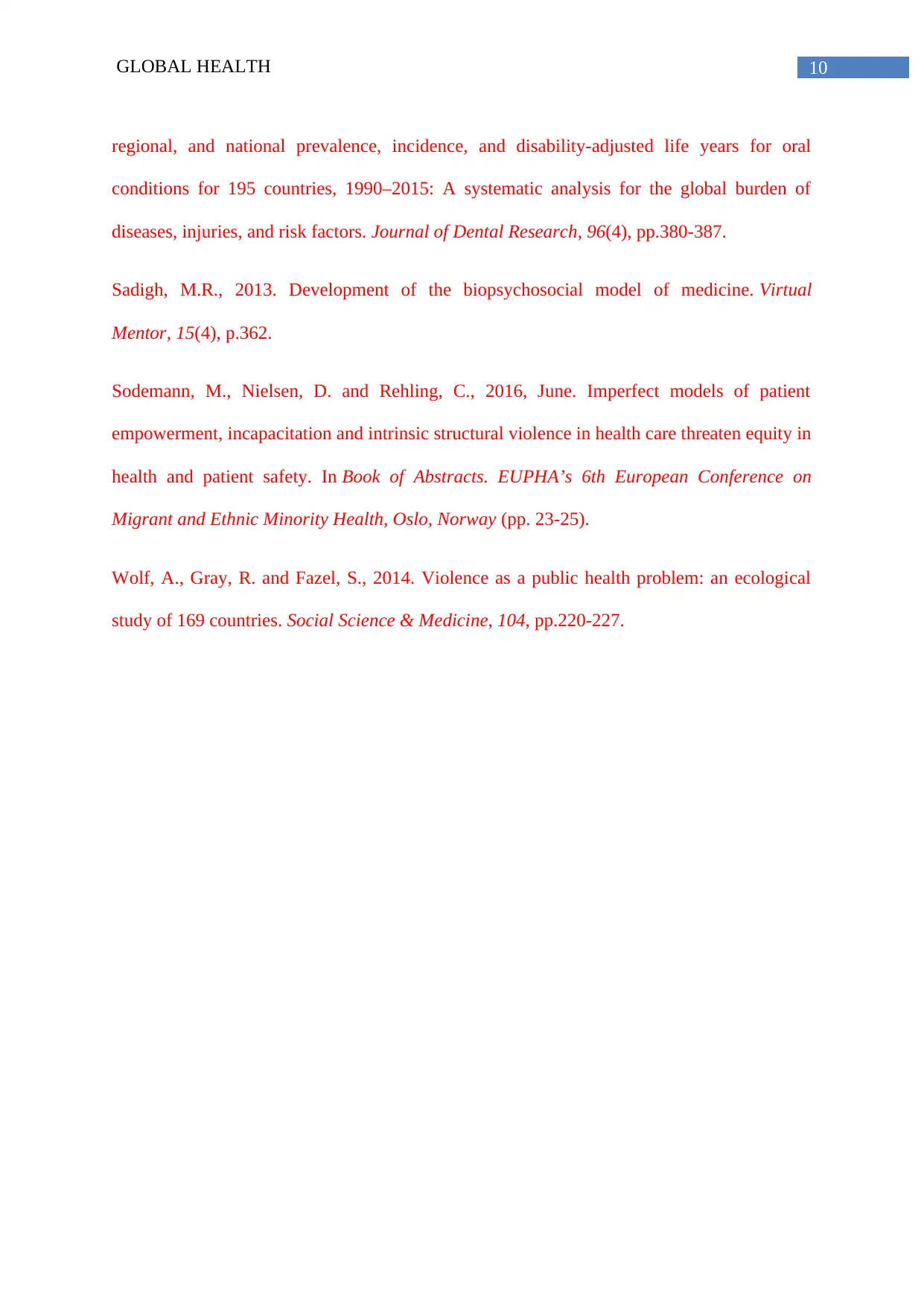
10GLOBAL HEALTH
regional, and national prevalence, incidence, and disability-adjusted life years for oral
conditions for 195 countries, 1990–2015: A systematic analysis for the global burden of
diseases, injuries, and risk factors. Journal of Dental Research, 96(4), pp.380-387.
Sadigh, M.R., 2013. Development of the biopsychosocial model of medicine. Virtual
Mentor, 15(4), p.362.
Sodemann, M., Nielsen, D. and Rehling, C., 2016, June. Imperfect models of patient
empowerment, incapacitation and intrinsic structural violence in health care threaten equity in
health and patient safety. In Book of Abstracts. EUPHA’s 6th European Conference on
Migrant and Ethnic Minority Health, Oslo, Norway (pp. 23-25).
Wolf, A., Gray, R. and Fazel, S., 2014. Violence as a public health problem: an ecological
study of 169 countries. Social Science & Medicine, 104, pp.220-227.
regional, and national prevalence, incidence, and disability-adjusted life years for oral
conditions for 195 countries, 1990–2015: A systematic analysis for the global burden of
diseases, injuries, and risk factors. Journal of Dental Research, 96(4), pp.380-387.
Sadigh, M.R., 2013. Development of the biopsychosocial model of medicine. Virtual
Mentor, 15(4), p.362.
Sodemann, M., Nielsen, D. and Rehling, C., 2016, June. Imperfect models of patient
empowerment, incapacitation and intrinsic structural violence in health care threaten equity in
health and patient safety. In Book of Abstracts. EUPHA’s 6th European Conference on
Migrant and Ethnic Minority Health, Oslo, Norway (pp. 23-25).
Wolf, A., Gray, R. and Fazel, S., 2014. Violence as a public health problem: an ecological
study of 169 countries. Social Science & Medicine, 104, pp.220-227.
1 out of 10
Related Documents
Your All-in-One AI-Powered Toolkit for Academic Success.
+13062052269
info@desklib.com
Available 24*7 on WhatsApp / Email
![[object Object]](/_next/static/media/star-bottom.7253800d.svg)
Unlock your academic potential
Copyright © 2020–2025 A2Z Services. All Rights Reserved. Developed and managed by ZUCOL.





